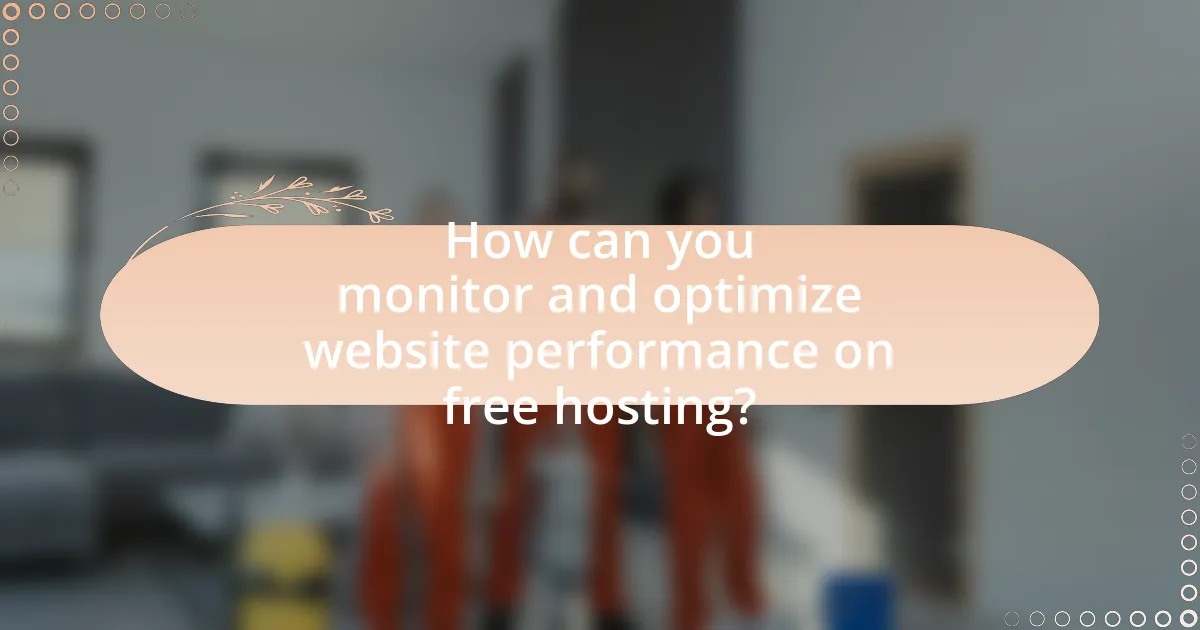Scaling a website on free hosting presents various challenges due to limited resources and performance constraints. Key issues include restricted bandwidth, storage limitations, and inadequate server capabilities, which can lead to slow loading times and potential downtime during high traffic periods. The article explores how these constraints affect website performance, common misconceptions about free hosting, and the risks associated with relying solely on such services. Additionally, it discusses advanced load management techniques, including caching strategies and the use of Content Delivery Networks (CDNs), to optimize performance and enhance scalability, even within the limitations of free hosting environments.

What are the challenges of scaling a website on free hosting?
Scaling a website on free hosting presents significant challenges, primarily due to limited resources and performance constraints. Free hosting services often impose restrictions on bandwidth, storage, and server capabilities, which can lead to slow loading times and downtime as traffic increases. For instance, many free hosting providers limit the number of concurrent users, resulting in potential crashes during peak traffic periods. Additionally, the lack of customer support and technical assistance can hinder troubleshooting and optimization efforts, making it difficult to implement advanced load management techniques effectively. These limitations can ultimately affect user experience and site reliability, impacting overall growth and scalability.
How does free hosting limit website scalability?
Free hosting limits website scalability primarily due to restricted resources and performance capabilities. These services often impose bandwidth caps, storage limits, and reduced server performance, which can hinder a website’s ability to handle increased traffic or data demands. For instance, many free hosting providers allocate minimal CPU and RAM resources, leading to slower load times and potential downtime during peak usage. Additionally, free hosting typically lacks advanced features such as load balancing and content delivery networks, which are essential for efficiently managing high traffic volumes. Consequently, websites hosted on free platforms may struggle to grow and adapt to user demands, ultimately affecting their overall performance and reliability.
What specific resource constraints do free hosting services impose?
Free hosting services impose specific resource constraints such as limited storage space, restricted bandwidth, and reduced processing power. These limitations often result in slower website performance and increased downtime, as users may experience throttling during peak traffic times. For example, many free hosting providers allocate only a few hundred megabytes of storage and impose bandwidth caps of 1-5 GB per month, which can severely restrict the ability to host media-rich content or handle high visitor volumes. Additionally, free hosting services may limit the number of databases or email accounts, further constraining functionality and scalability for users.
How do these constraints affect website performance during high traffic?
High traffic constraints negatively impact website performance by causing slower load times, increased latency, and potential downtime. When a website hosted on free services encounters high traffic, limited server resources such as bandwidth and processing power become strained, leading to slower response times. For instance, studies show that a one-second delay in page load time can result in a 7% reduction in conversions, highlighting the critical nature of performance during peak traffic. Additionally, free hosting often lacks the scalability features necessary to handle sudden traffic spikes, which can lead to server crashes or unavailability, further degrading user experience.
What are the common misconceptions about free hosting?
Common misconceptions about free hosting include the belief that it offers unlimited resources, that it is suitable for professional websites, and that it guarantees security and reliability. Many users assume free hosting provides unlimited bandwidth and storage, but most services impose strict limits, which can lead to performance issues. Additionally, free hosting is often viewed as a viable option for business websites; however, it typically lacks essential features like custom domain names and professional support, which can hinder credibility. Lastly, users may think free hosting is secure, but these services often lack robust security measures, making websites vulnerable to attacks and data breaches.
Why do some believe free hosting is sufficient for all types of websites?
Some believe free hosting is sufficient for all types of websites because it offers basic functionality without financial investment. Many individuals and small businesses view free hosting as a viable option for personal blogs, portfolios, or small-scale projects that do not require extensive resources or high traffic management. Statistics indicate that a significant portion of new websites are launched on free hosting platforms, demonstrating their appeal for users seeking cost-effective solutions. Additionally, free hosting services often provide essential features such as website builders and templates, making it accessible for users with limited technical skills.
What are the risks associated with relying solely on free hosting?
Relying solely on free hosting poses significant risks, including limited resources, lack of customer support, and potential data loss. Free hosting services often impose restrictions on bandwidth, storage, and performance, which can hinder website scalability and user experience. Additionally, these services typically do not offer reliable customer support, leaving users without assistance during critical issues. Furthermore, free hosting providers may not guarantee data security, increasing the risk of data loss or breaches, as evidenced by numerous reports of compromised free hosting accounts.

What advanced load management techniques can be applied to free hosting?
Advanced load management techniques applicable to free hosting include resource throttling, caching strategies, and load balancing. Resource throttling limits the amount of CPU and memory usage per user, ensuring that no single user can monopolize resources, which is crucial in a shared environment. Caching strategies, such as using Content Delivery Networks (CDNs) or server-side caching, reduce server load by storing frequently accessed data closer to users, thus improving response times and reducing bandwidth consumption. Load balancing distributes incoming traffic across multiple servers or instances, which can enhance performance and reliability, even in free hosting scenarios where resources are limited. These techniques are validated by their widespread use in optimizing performance and resource allocation in various hosting environments.
How can caching improve website performance on free hosting?
Caching can significantly improve website performance on free hosting by reducing server load and decreasing page load times. When a website utilizes caching, frequently accessed data is stored temporarily, allowing subsequent requests for that data to be served quickly from the cache rather than requiring a full server response. This is particularly beneficial on free hosting platforms, which often have limited resources and bandwidth.
For instance, studies show that websites employing caching can achieve load time reductions of up to 70%, leading to enhanced user experience and lower bounce rates. Additionally, by minimizing the number of requests made to the server, caching helps to prevent server overload, which is crucial for maintaining performance on free hosting services that may struggle with high traffic.
What types of caching are most effective for free hosting environments?
The most effective types of caching for free hosting environments are file caching and object caching. File caching stores static files, such as images and stylesheets, on the server to reduce load times and server requests. Object caching, on the other hand, temporarily stores database query results in memory, which significantly speeds up data retrieval for dynamic content. Both methods are particularly beneficial in free hosting scenarios where resources are limited, as they minimize server load and improve response times, leading to a better user experience.
How can caching strategies be implemented without server access?
Caching strategies can be implemented without server access by utilizing client-side caching techniques, such as browser caching and service workers. Browser caching allows web browsers to store static resources like images, CSS, and JavaScript files locally, reducing the need to fetch them from the server repeatedly. Service workers can intercept network requests and serve cached responses, enabling offline capabilities and faster load times. These methods leverage HTTP caching headers, such as Cache-Control and ETag, to manage how resources are cached and updated. By effectively using these client-side techniques, websites can enhance performance and reduce server load without requiring direct server modifications.
What role does content delivery network (CDN) play in scaling?
A content delivery network (CDN) plays a crucial role in scaling by distributing content across multiple servers located in various geographic locations. This distribution reduces latency and improves load times for users, as content is served from the nearest server rather than a single origin server. According to a study by Akamai, using a CDN can lead to a 50% reduction in load times, significantly enhancing user experience and allowing websites to handle increased traffic without performance degradation. This capability is essential for scaling, especially during traffic spikes, as it enables efficient resource management and ensures high availability of content.
How can a CDN enhance load times for users on free hosting?
A Content Delivery Network (CDN) can enhance load times for users on free hosting by distributing content across multiple geographically dispersed servers. This distribution allows users to access data from a server that is physically closer to them, reducing latency and improving load speed. For instance, studies show that using a CDN can decrease load times by up to 50% in some cases, as it minimizes the distance data must travel. Additionally, CDNs often employ caching techniques, which store copies of static content, further accelerating access for users. This combination of proximity and caching significantly optimizes the user experience on free hosting platforms, which may otherwise suffer from slower load times due to limited server resources.
What are the best CDN options for websites on free hosting?
The best CDN options for websites on free hosting include Cloudflare, jsDelivr, and Google Cloud CDN. Cloudflare offers a free tier that provides global content delivery, DDoS protection, and performance optimization, making it ideal for free hosting environments. jsDelivr is a free CDN specifically designed for open-source projects, allowing users to serve files from multiple sources efficiently. Google Cloud CDN, while primarily a paid service, offers a free tier with limited usage that can be beneficial for small projects. These CDNs enhance website performance and reliability, even on free hosting platforms, by reducing latency and improving load times.

How can you monitor and optimize website performance on free hosting?
To monitor and optimize website performance on free hosting, utilize tools like Google PageSpeed Insights and GTmetrix to analyze loading times and performance metrics. These tools provide specific recommendations for improvements, such as optimizing images, leveraging browser caching, and minimizing JavaScript and CSS files. Implementing these suggestions can lead to faster load times, which is crucial since studies show that a one-second delay in page response can result in a 7% reduction in conversions. Additionally, regularly checking server response times and uptime through services like UptimeRobot can help identify issues that may affect performance. By combining these monitoring tools with optimization techniques, website performance on free hosting can be significantly enhanced.
What tools are available for monitoring website performance?
Tools available for monitoring website performance include Google PageSpeed Insights, GTmetrix, Pingdom, and New Relic. Google PageSpeed Insights evaluates the performance of web pages and provides suggestions for improvement based on real-world data. GTmetrix combines Google Lighthouse and WebPageTest to analyze page speed and performance metrics. Pingdom offers uptime monitoring and performance insights, allowing users to track website speed from various locations. New Relic provides detailed performance analytics and monitoring for applications, helping developers optimize their websites. These tools are widely used in the industry for their effectiveness in identifying performance issues and enhancing user experience.
How can these tools help identify bottlenecks in performance?
These tools can help identify bottlenecks in performance by providing real-time monitoring and analytics of system metrics. They track key performance indicators such as response times, server load, and resource utilization, allowing users to pinpoint areas where performance lags. For instance, tools like New Relic and Google Analytics can reveal slow database queries or high CPU usage, which are common bottlenecks. By analyzing this data, users can make informed decisions to optimize their website’s performance, such as adjusting server configurations or optimizing code.
What metrics should be prioritized for optimization?
The metrics that should be prioritized for optimization include page load time, server response time, and user engagement metrics such as bounce rate and session duration. Page load time is critical as studies show that a one-second delay can lead to a 7% reduction in conversions. Server response time impacts how quickly a server can process requests, with optimal response times being under 200 milliseconds to enhance user experience. User engagement metrics, specifically bounce rate and session duration, provide insights into how effectively content retains visitors, with lower bounce rates indicating better user satisfaction and higher session durations suggesting more engaging content. Prioritizing these metrics can significantly improve website performance and user experience on free hosting platforms.
What are the best practices for optimizing website content?
The best practices for optimizing website content include using relevant keywords, ensuring mobile-friendliness, improving page load speed, and creating high-quality, engaging content. Relevant keywords should be strategically placed in titles, headings, and throughout the text to enhance search engine visibility. Mobile-friendliness is crucial, as over 50% of web traffic comes from mobile devices, necessitating responsive design. Page load speed is vital; studies show that a one-second delay can reduce conversions by 7%. High-quality content that addresses user needs and incorporates multimedia elements can increase engagement and reduce bounce rates.
How can image optimization reduce load times?
Image optimization can significantly reduce load times by decreasing the file size of images without compromising quality. When images are optimized, they are compressed and resized appropriately, which minimizes the amount of data that needs to be transferred when a webpage is loaded. For instance, studies have shown that optimized images can reduce load times by up to 80%, leading to faster page rendering and improved user experience. Additionally, tools like JPEG compression and image formats such as WebP can further enhance loading speeds, as they provide better compression rates compared to traditional formats.
What techniques can be used to minimize CSS and JavaScript files?
To minimize CSS and JavaScript files, techniques such as minification, concatenation, and compression can be employed. Minification involves removing unnecessary characters, such as whitespace and comments, from the code without affecting its functionality, which can significantly reduce file size. Concatenation combines multiple CSS or JavaScript files into a single file, reducing the number of HTTP requests needed to load a webpage, thereby improving load times. Compression, using methods like Gzip, further reduces file sizes during transmission over the network. These techniques collectively enhance website performance, especially on free hosting platforms where resource limitations may exist.
What troubleshooting steps can be taken when performance issues arise?
To address performance issues, first, identify the specific symptoms, such as slow loading times or unresponsive pages. Next, check server resource usage, including CPU and memory, to determine if limits are being reached. Analyze website traffic to identify any spikes that may be causing overload. Review error logs for any server-side issues that could impact performance. Optimize images and other media to reduce load times. Implement caching strategies to improve response times. Finally, consider upgrading to a paid hosting plan if performance issues persist, as free hosting often has limitations on resources.
How can you identify the source of slow loading times?
To identify the source of slow loading times, utilize performance monitoring tools such as Google PageSpeed Insights, GTmetrix, or WebPageTest. These tools analyze various factors affecting load speed, including server response time, image sizes, and script execution times. For instance, Google PageSpeed Insights provides specific metrics like Time to First Byte (TTFB) and identifies opportunities for optimization, such as reducing server response time or leveraging browser caching. By systematically reviewing these metrics, you can pinpoint the exact elements causing delays and implement targeted improvements.
What common fixes can be applied to improve performance on free hosting?
To improve performance on free hosting, optimizing website assets is essential. This includes compressing images, minifying CSS and JavaScript files, and leveraging browser caching to reduce load times. Studies show that optimized images can reduce page size by up to 80%, significantly enhancing loading speed. Additionally, using a Content Delivery Network (CDN) can distribute content more efficiently, decreasing latency and improving user experience. Implementing these fixes can lead to faster load times and better overall performance on free hosting platforms.